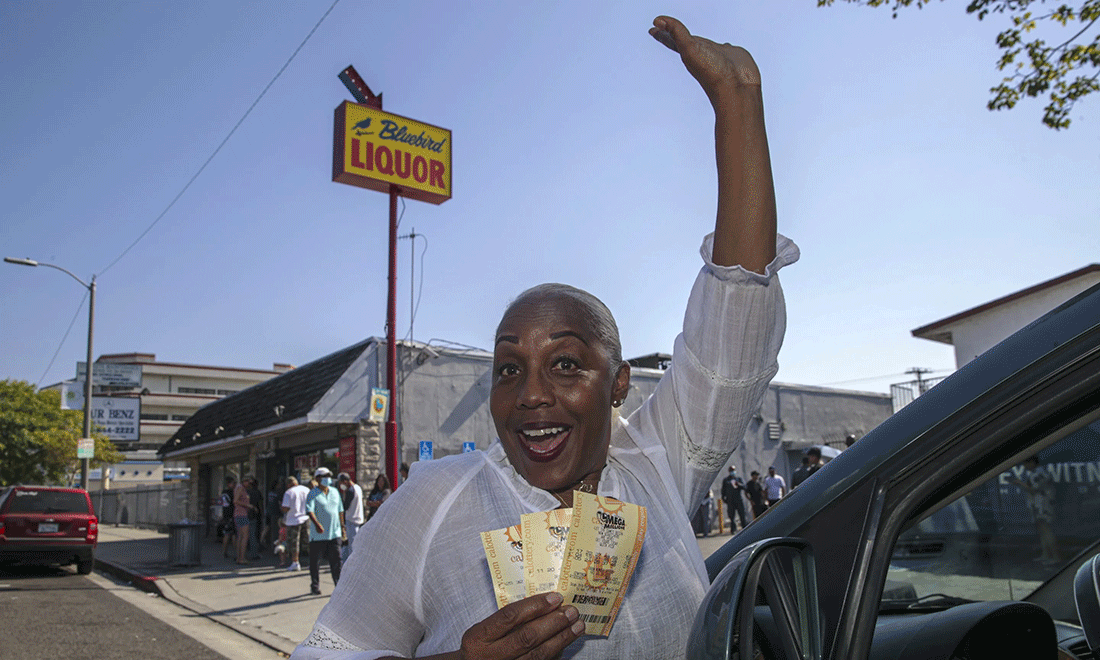
今年1月初,最新的可供竞购的“超级百万”(Mega Millions)彩票头奖高达9.4亿美元。也许就像电影《查理和巧克力工厂》(Charlie and the Chocolate Factory)里查理的祖父那样,这一数字足以帮助我们消除1月的忧郁情绪,让我们从床上爬起来,去街角的商店或加油站,希望能够买到一点(或者很多)好运。
很难概念化一个这么高的数字,这也是问题所在。巨额奖金——历史上第六高大奖——是美联社(Associated Press)所称的“头奖的黄金时代”的一部分。不仅仅是“超级百万”彩票让更多人面临风险;这些天,彩票奖金的金额比往常要高得多。
2022年11月的强力球(Powerball)彩票大奖是历史上最高的头奖:可以开出创纪录的20.4亿美元奖金。在连续40次开奖都没有中奖的情况下,中奖金额激增。2022年夏天,美国第三高“超级百万”彩票头奖能够开出超过10亿美元的奖金。
仅追溯到2016年,美国历史上所有最高的头奖都是最近爆出的。正如美联社解释的那样,“超级百万”和强力球彩票官员都在21世纪10年代中期改变了规则,使得头奖难以中奖,从而随着时间的推移增加了头奖金额,并吸引更多的人购买乐透彩票,人们都希望挑战不可能。强力球彩票在2022年还推出了第三次每周开奖,随着更多的人参与,并且没有人中得头奖,头奖金额变得更高。
目前的“超级百万”彩票头奖,最后一次开奖是在1月3日,已经有23次开奖,没有出现头奖中奖者。也许这是因为中头奖的机会仅为3.026亿分之一。
这与2022年7月10多亿美元的“超级百万”彩票头奖的中奖机会大致相同:3.025亿分之一。正如《财富》杂志的克里斯·莫里斯所指出的,美国人口不到3.33亿。甚至被闪电击中的几率都比中头奖高。
“头奖的黄金时代”提供了在金融上逃避现实的消遣方式
迫在眉睫的经济衰退和不断上升的通货膨胀让许多人在这些日子里寻求财务安全。尽管2022年的就业市场相对强劲,但随着体验经济的恢复和生活成本的上升,美国人不得不动用他们在新冠疫情期间的储蓄。世界大型企业联合会(Conference Board)的消费者信心指数(Consumer Confidence Index)显示,尽管通胀在缓慢回落,但消费者信心却在下降:2022年10月,只有17.5%的消费者认为商业状况良好,23.3%的消费者预计未来六个月情况会恶化。
就连中上阶层人士也感到财务上的焦虑。布鲁金斯学会(Brookings Institution)的高级研究员温迪·埃德尔伯格在2022年春天对《财富》杂志表示:“对一些表现良好、财务状况比2019年更好的家庭来说,他们的财务缓冲正在减少。”
这助长了人们对中奖的迷恋,美国人希望彩票能够将他们从经济绝望中拯救出来,并助力恢复中产阶级的黄金时代。据《财富》杂志的史蒂夫·莫尔曼报道,在强力球彩票开奖期间,人们的兴趣激增,以至于当地广播报道了人们对自动贩卖机故障的失望,这一故障可能与销量激增有关。(虽然越来越多的人购买彩票,但每次开奖时他们购买的数量比六年前要少。)
2018年,弗吉尼亚大学(University of Virginia)的博士生乔纳森·科恩完成了一篇关于美国彩票的论文,他在接受彭博社(Bloomberg)采访时说:“彩票已经成为社会流动性的替代机制——在一个机会越来越少的经济体中获得经济成功的一种方式。有一种观点认为美国经济被操纵,实现成功和致富的最佳机会是买彩票中奖,而不是通过辛勤工作或积累储蓄,这是可以理解的。”
这些头奖实际上并没有看上去那么高。如果中奖者选择一次性领取,而不是通常的29年内逐年分期领取奖金,他们获得的奖金就会少很多。如果有人在1月初中了“超级百万”彩票头奖,并选择一次性领取,他们预计将获得不到一半的奖金,即4.835亿美元。这些奖金都是税前的,而各州的税率不同。
但这仍然是一罐金子——即使近来更难淘到金子。(财富中文网)
译者:中慧言-王芳
今年1月初,最新的可供竞购的“超级百万”(Mega Millions)彩票头奖高达9.4亿美元。也许就像电影《查理和巧克力工厂》(Charlie and the Chocolate Factory)里查理的祖父那样,这一数字足以帮助我们消除1月的忧郁情绪,让我们从床上爬起来,去街角的商店或加油站,希望能够买到一点(或者很多)好运。
很难概念化一个这么高的数字,这也是问题所在。巨额奖金——历史上第六高大奖——是美联社(Associated Press)所称的“头奖的黄金时代”的一部分。不仅仅是“超级百万”彩票让更多人面临风险;这些天,彩票奖金的金额比往常要高得多。
2022年11月的强力球(Powerball)彩票大奖是历史上最高的头奖:可以开出创纪录的20.4亿美元奖金。在连续40次开奖都没有中奖的情况下,中奖金额激增。2022年夏天,美国第三高“超级百万”彩票头奖能够开出超过10亿美元的奖金。
仅追溯到2016年,美国历史上所有最高的头奖都是最近爆出的。正如美联社解释的那样,“超级百万”和强力球彩票官员都在21世纪10年代中期改变了规则,使得头奖难以中奖,从而随着时间的推移增加了头奖金额,并吸引更多的人购买乐透彩票,人们都希望挑战不可能。强力球彩票在2022年还推出了第三次每周开奖,随着更多的人参与,并且没有人中得头奖,头奖金额变得更高。
目前的“超级百万”彩票头奖,最后一次开奖是在1月3日,已经有23次开奖,没有出现头奖中奖者。也许这是因为中头奖的机会仅为3.026亿分之一。
这与2022年7月10多亿美元的“超级百万”彩票头奖的中奖机会大致相同:3.025亿分之一。正如《财富》杂志的克里斯·莫里斯所指出的,美国人口不到3.33亿。甚至被闪电击中的几率都比中头奖高。
“头奖的黄金时代”提供了在金融上逃避现实的消遣方式
迫在眉睫的经济衰退和不断上升的通货膨胀让许多人在这些日子里寻求财务安全。尽管2022年的就业市场相对强劲,但随着体验经济的恢复和生活成本的上升,美国人不得不动用他们在新冠疫情期间的储蓄。世界大型企业联合会(Conference Board)的消费者信心指数(Consumer Confidence Index)显示,尽管通胀在缓慢回落,但消费者信心却在下降:2022年10月,只有17.5%的消费者认为商业状况良好,23.3%的消费者预计未来六个月情况会恶化。
就连中上阶层人士也感到财务上的焦虑。布鲁金斯学会(Brookings Institution)的高级研究员温迪·埃德尔伯格在2022年春天对《财富》杂志表示:“对一些表现良好、财务状况比2019年更好的家庭来说,他们的财务缓冲正在减少。”
这助长了人们对中奖的迷恋,美国人希望彩票能够将他们从经济绝望中拯救出来,并助力恢复中产阶级的黄金时代。据《财富》杂志的史蒂夫·莫尔曼报道,在强力球彩票开奖期间,人们的兴趣激增,以至于当地广播报道了人们对自动贩卖机故障的失望,这一故障可能与销量激增有关。(虽然越来越多的人购买彩票,但每次开奖时他们购买的数量比六年前要少。)
2018年,弗吉尼亚大学(University of Virginia)的博士生乔纳森·科恩完成了一篇关于美国彩票的论文,他在接受彭博社(Bloomberg)采访时说:“彩票已经成为社会流动性的替代机制——在一个机会越来越少的经济体中获得经济成功的一种方式。有一种观点认为美国经济被操纵,实现成功和致富的最佳机会是买彩票中奖,而不是通过辛勤工作或积累储蓄,这是可以理解的。”
这些头奖实际上并没有看上去那么高。如果中奖者选择一次性领取,而不是通常的29年内逐年分期领取奖金,他们获得的奖金就会少很多。如果有人在1月初中了“超级百万”彩票头奖,并选择一次性领取,他们预计将获得不到一半的奖金,即4.835亿美元。这些奖金都是税前的,而各州的税率不同。
但这仍然是一罐金子——即使近来更难淘到金子。(财富中文网)
译者:中慧言-王芳
In early January 2023, $940 million is up for grabs in the latest Mega Millions jackpot drawing. It’s a number that’s enough to help beat the January blues and possibly, like Charlie’s grandfather in Charlie and the Chocolate Factory, get us all out of bed and down to a corner store or gas station in hopes of buying a bit (or a lot) of luck.
It’s hard to conceptualize a number that high, and that’s partly the point. The enormous winnings—the sixth-largest jackpot in history—are part of the “golden age of jackpots,” as the Associated Press calls it. It’s not just Mega Millions putting more on the line; these days, lotteries are more mega than usual.
November’s Powerball prize was the largest jackpot in history: a record-breaking $2.04 billion. The sum surged after 40 consecutive drawings without a winner. And last summer, over $1 billion was on the line in the nation’s third largest Mega Millions jackpot.
All the largest jackpots in U.S. history are quite recent, dating back only to 2016. As the AP explains it, both Mega Millions and Powerball officials implemented rule changes in the mid-2010s that made jackpots difficult to win, thereby increasing the jackpot amount over time and enticing more people to buy lotto tickets in hopes of defying the odds. Powerball also introduced a third weekly drawing in 2022, making the jackpot heftier as more people participated and lost.
The current Mega Millions jackpot, last drawn on January 3, has seen 23 drawings without a grand prize winner. Maybe that’s because the odds of winning are one in 302.6 million.
That’s roughly around the same odds of July’s $1 billion-plus Mega Millions jackpot: one in 302.5 million. As Fortune’s Chris Morris points out, the U.S. population is just under 333 million. Even the odds of getting hit by lightning are better than winning the lottery.
The “golden age of the jackpot” offers financial escapism
A looming recession and rising inflation have left many people seeking financial security these days. Despite last year’s relatively sturdy job market, Americans had to dip into their pandemic savings as the experience economy resumed and the cost of living rose. Even as inflation slowly ebbs, consumer confidence is down, the Conference Board Consumer Confidence Index finds: In October only 17.5% of consumers said business conditions were good, and 23.3% said they expected conditions to worsen in six months.
Even the upper middle class has been feeling financially anxious. “For some households who are doing well and who are financially better off than they were in 2019, they are nonetheless seeing that financial buffer decrease,” Wendy Edelberg, senior fellow at Brookings, told Fortune last spring.
It’s fueling a fascination with winning the lottery, which Americans hope will save them from their economic despair and help revive the middle class’s golden era. The interest during Powerball’s jackpot spiked so much that local broadcasts reported on frustration with glitches in ticket machines, potentially linked to an inundation in sales, Fortune’s Steve Mollman reported. (Although more people are buying tickets, they’re buying fewer of them for each drawing than they did about six years ago.)
“Lotteries have become an alternative mechanism of social mobility—a way of achieving financial success in an economy that’s increasingly bereft of those opportunities,” Jonathan Cohen, a Ph.D. candidate at the University of Virginia who’s completed a dissertation on American lotteries, told Bloomberg back in 2018. “There’s an understandable belief that the economy is rigged and your best chance of making it out and getting rich is through the lottery, not through your job or savings.”
Not that any of these jackpots are actually as big as they appear to be. If winners opt for the cash payout instead of the 29 years in annuity, which they usually do, they take home way less. If someone wins the Mega Millions in early January and does just that, they’ll bank less than half of the projected prize at $483.5 million. That’s all before taxes, which vary by state.
But that’s still a pot of gold—even if it is more difficult to strike gold as of late.






